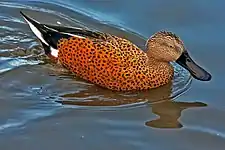Spatula (genus)
Spatula is a genus or subgenus of ducks in the family Anatidae that includes the shovelers and some of the teals.
| Spatula | |
|---|---|
 | |
| Male northern shoveler | |
| Scientific classification | |
| Kingdom: | Animalia |
| Phylum: | Chordata |
| Class: | Aves |
| Order: | Anseriformes |
| Family: | Anatidae |
| Tribe: | Anatini |
| Genus: | Spatula Boie, F. 1822 |
| Type species | |
| Spatula clypeata | |
| Synonyms | |
| |
Taxonomy
The species now placed in this genus were formerly placed in the genus Anas. A molecular phylogentic study comparing mitochondrial DNA sequences published in 2009 found that the genus Anas, as then defined, was non-monophyletic.[2] Based on this published phylogeny, the genus Anas was split into four monophyletic genera with ten species moved into the resurrected genus Spatula.[3]
The genus Spatula had originally been proposed by the German zoologist Friedrich Boie in 1822. The type species is the northern shoveler.[4][5] The name Spatula is the Latin for a "spoon" or "spatula".[6]
Extant Species
The genus contains 10 species:[3]
| Image | Scientific name | Common Name | Distribution |
|---|---|---|---|
_RWD3.jpg.webp) | S. querquedula | Garganey | Europe and western Asia |
_RWD1.jpg.webp) | S. hottentota | Blue-billed teal | eastern and southern Africa, from Sudan and Ethiopia west to Niger and Nigeria and south to South Africa and Namibia |
_(20806408792).jpg.webp) | S. puna | Puna teal | the Andes of Peru, western Bolivia, northern Chile, and extreme northwestern Argentina |
_RWD1.jpg.webp) | S. versicolor | Silver teal | southern Bolivia, southern Brazil, Paraguay, Argentina, Chile, Uruguay, South Georgia, South Sandwich Islands, and the Falkland Islands |
 | S. platalea | Red shoveler | from Tierra del Fuego northwards to Chile and most parts of Argentina, as well as to the Falkland Islands, and there are small isolated breeding populations in southern Peru. |
 | S. cyanoptera | Cinnamon teal | South America, western United States, and extreme southwestern Canada, and are rare visitors to the east coast of the United States |
 | S. discors | Blue-winged teal | North America, where it breeds from southern Alaska to Nova Scotia, and south to northern Texas. |
 | S. smithii | Cape shoveler | South Africa, and uncommon further north in Namibia, Botswana, Zimbabwe, southern Angola, Lesotho, Mozambique, and Zambia |
 | S. rhynchotis | Australasian shoveler | Australia, Tasmania, and New Zealand |
_(3).JPG.webp) | S. clypeata | Northern shoveler | northern areas of Europe and Asia and across most of North America |
References
- "Part 7- Vertebrates". Collection of genus-group names in a systematic arrangement. Retrieved 30 June 2016.
- Gonzalez, J.; Düttmann, H.; Wink, M. (2009). "Phylogenetic relationships based on two mitochondrial genes and hybridization patterns in Anatidae". Journal of Zoology. 279: 310–318. doi:10.1111/j.1469-7998.2009.00622.x.
- Gill, Frank; Donsker, David, eds. (2017). "Screamers, ducks, geese & swans". World Bird List Version 7.3. International Ornithologists' Union. Retrieved 23 July 2017.
- Boie, Friedrich (1822). "Generalübersicht". Isis von Oken (in German). Col 564.
- Mayr, Ernst; Cottrell, G. William, eds. (1979). Check-list of Birds of the World. Volume 1 (2nd ed.). Cambridge, Massachusetts: Museum of Comparative Zoology. p. 460.
- Jobling, James A. (2010). The Helm Dictionary of Scientific Bird Names. London: Christopher Helm. p. 361. ISBN 978-1-4081-2501-4.
| Wikimedia Commons has media related to Spatula. |
This article is issued from Wikipedia. The text is licensed under Creative Commons - Attribution - Sharealike. Additional terms may apply for the media files.